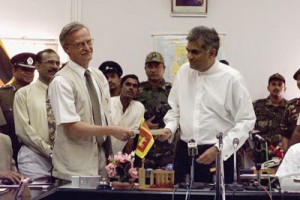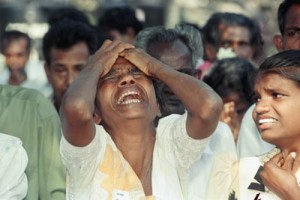Sri Lanka:Animosity in the last stages of war could be permanent scar in ethnic relations
Last attempt
The Norwegian government’s effort to facilitate a peace process in the period 2002-06 was the last attempt to achieve peace in Sri Lanka’s war through peaceful means. The publication of an evaluation report by the Norwegian government to assess what happened during that period and to

Jon Westburg former Norwegian Ambassador to Colombo, shaking the hand of then Prime Minister Ranil Wickramasinghe after signing the CFA agreement on 22 February 2002.
draw relevant lessons for the future has rekindled debate about the failed peace process. The terms of reference of the evaluation stated that its main purpose was to learn from Norway’s experience. An important objective marked out for the evaluation was to provide recommendations to learn from the failures in Sri Lanka to inform future peace processes elsewhere in the world and thereby contribute to the international discussion on conflict resolution.
Courageous
Prior to the Norwegian intervention in Sri Lanka there had been five attempts made by successive governments to negotiate an end to the war with the LTTE, including one which was mediated by India. The several efforts made to end the war through peaceful means were necessary and even courageous attempts though they failed. A resort to war is always the worst option if there are others available. As a result of the failures to negotiate a peaceful solution Sri Lanka’s internal war and terrorism lasted for three decades and ended only in May 2009 with the military defeat of the LTTE. The overall cost in terms of lives lost, property destroyed, development opportunities foregone, emotional suffering and migration of Sri Lankans was incalculable.
Bitter acrimony
If it had succeeded, the Norwegian peace effort would most likely have led to an outcome superior to that of a military solution and made a smoother transition to peace while providing a political solution. As it stands, the bitterness and animosity of the last stage of the war has the potential to
remain a permanent scar on the inter-ethnic relations unless there is a genuine reconciliation between the government and the Tamil leaders on the one hand and between the ethnic communities on the other. The example of Armenia comes to mind. For nearly a hundred years there has been bitter acrimony between Armenians who accuse Turkey of committing genocide against a million of their people, while Turkey continues to deny that a massacre ever took place.
Norway villified
The Norwegian-facilitated peace process had the goal of a peaceful solution through negotiations, and even reached a point where the government and LTTE agreed to explore a power sharing solution within a united Sri Lanka. However, after the peace process began to unravel in 2004, no country was more vilified in Sri Lanka than Norway. The evaluation report itself raises the question whether Norway overstayed its peacemaking role in Sri Lanka. However, those Norwegians who led the facilitative process remained true to their mission of being a bridge between the two warring sides in the ultimately vain hope of a change for the better. There is an implied criticism in the evaluation report that the Norwegian commitment to being a peacemaker and waiting till the very end overrode more practical considerations.
Undermining the peace process
One of the key failures of Norwegian facilitation critiqued in the evaluation report was the inability of the Norwegian facilitators to deal effectively with the deliberate violations of the Ceasefire Agreement by the LTTE. During the entirety of the ceasefire period the LTTE kept on assassinating its opponents and violating human rights. The evaluation report notes that these violations of the ceasefire severely undermined the legitimacy of the peace process and the role of Norway. Unfortunately, Sri Lankan civil society and non governmental groups who supported the peace process also hesitated in taking the LTTE to task and were not vigorous in demanding action against them. Their concern was to keep the LTTE in the peace process. But this only emboldened the LTTE to take their duplicity and brinkmanship to ever higher levels.
In dependent scrutiny
The report makes many criticisms of the Norwegian facilitation effort and how it took place. The willingness of the Norwegian government to subject its peace initiative to independent scrutiny, even critical scrutiny as in this case, is an example of transparency and openness. Sri Lanka needs to make its own self-critical assessment of why the peace process and political reform failed and learn the lesson that mere appeasement of those who are intransigent is not the answer. Now that the war is over, it is important that Norway and the international community continue to support Sri Lanka to achieve a political solution and post-war development. The war and terrorism arose out of a long festering ethnic conflict. The roots of this conflict still have to be addressed even though the war has ended.

